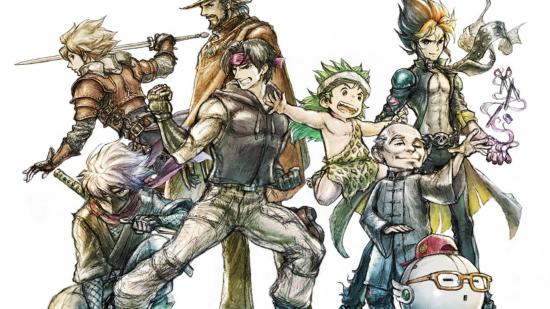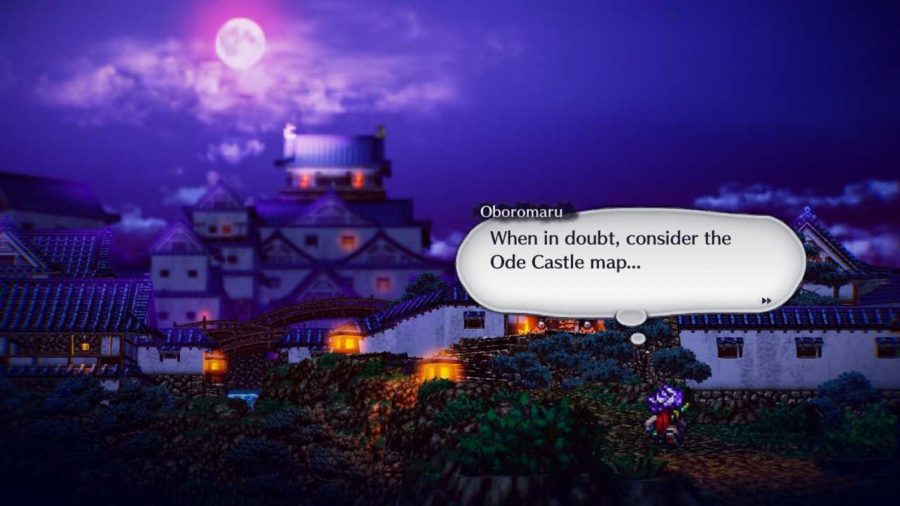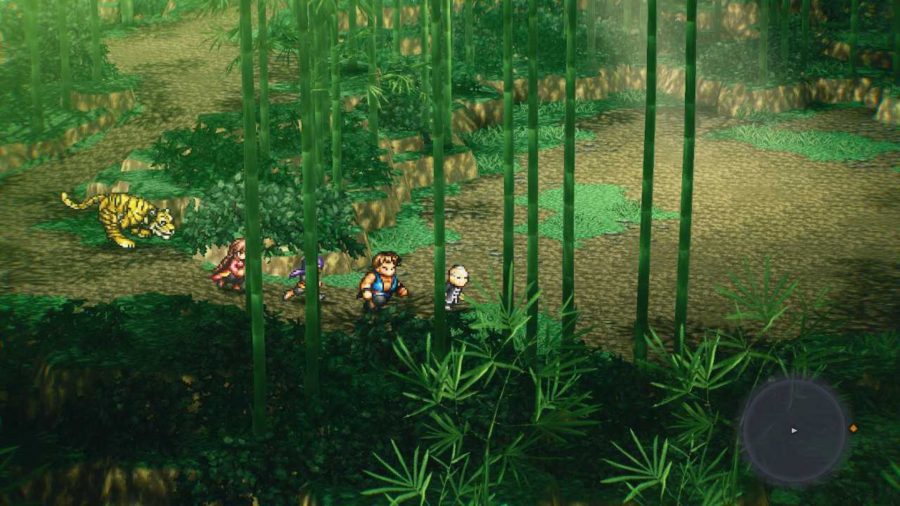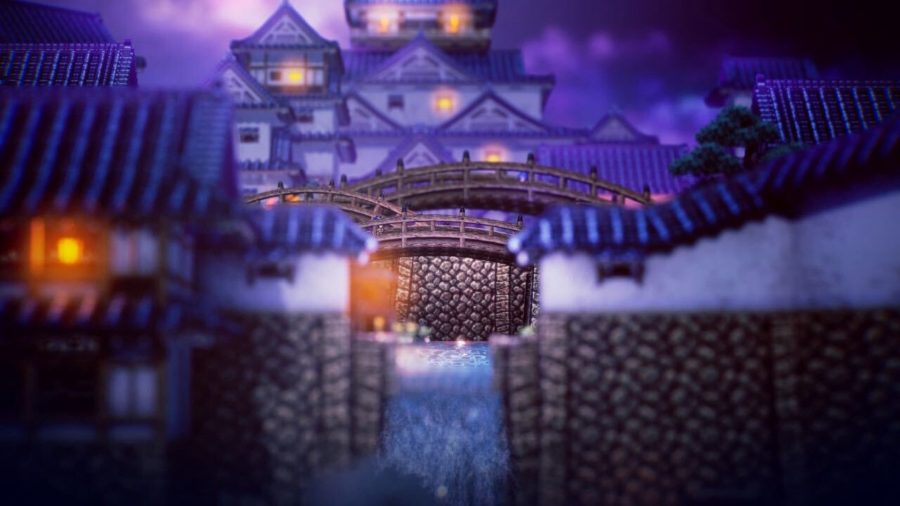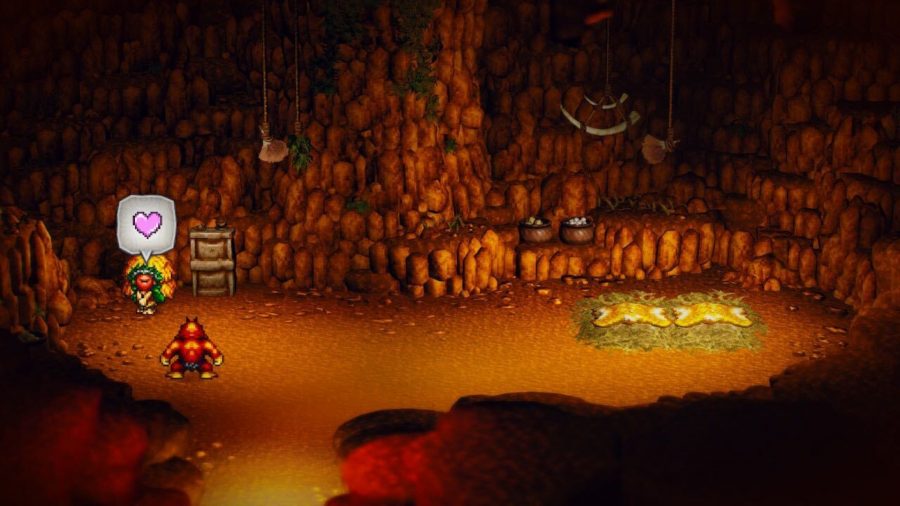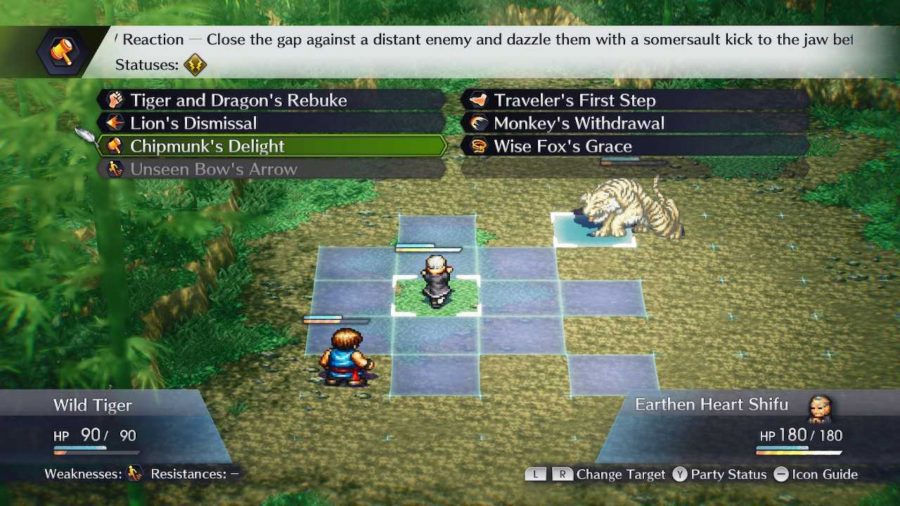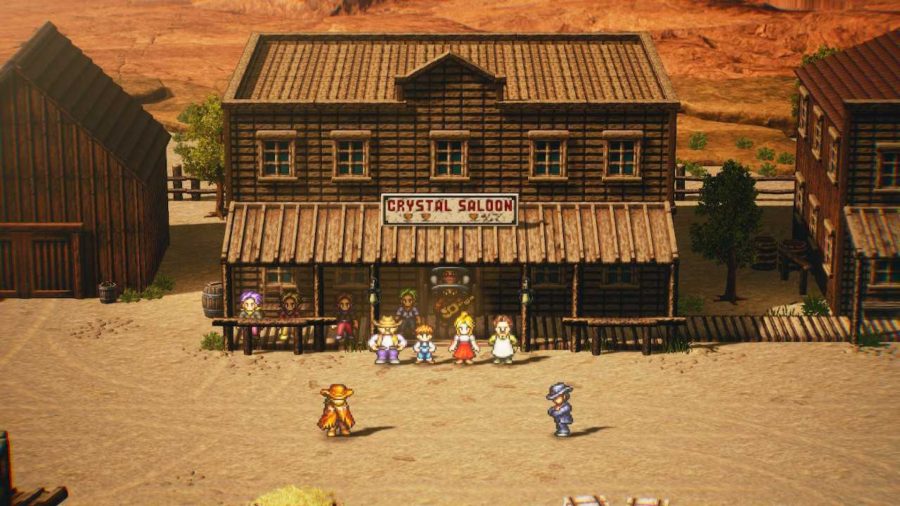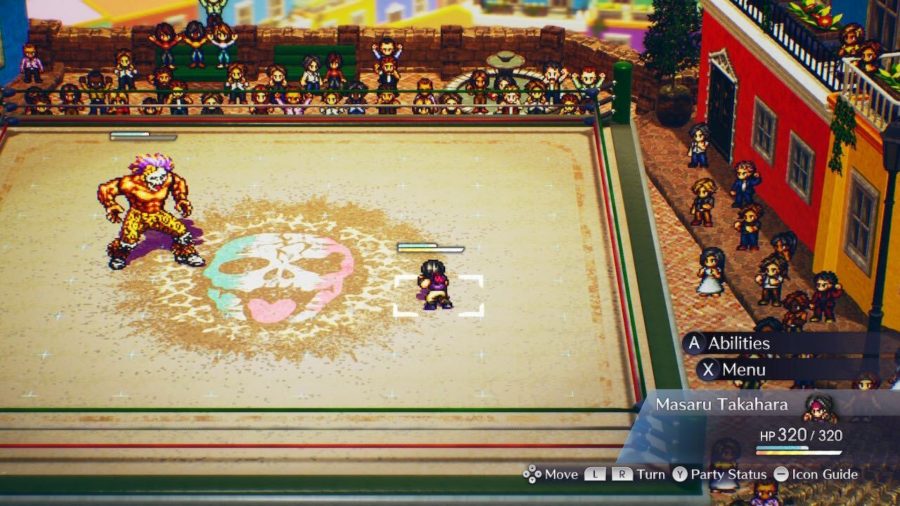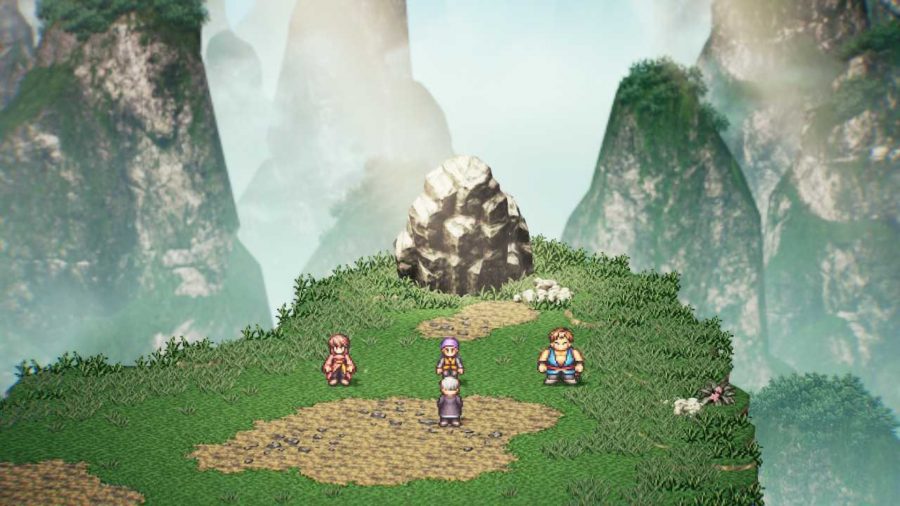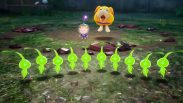The year is 1994. Square Enix releases a new game, one that breaks the mould and helps to usher in a new age for the industry. Now, nearly thirty years later, that same title makes an appearance once again, albeit with a vivacious update that breathes new life into Live A Live, an RPG that deserves your undivided attention.
If you’re not familiar with the original, one of the biggest draws of the classic title is its eight unique chapters, each of which centres on a different protagonist in varying locations and time periods, which is, of course, the case for the remake too. Better still, all eight of these are individually phenomenal to experience. In fact, in my humble opinion, none of them are weak. Each chapter holds its own, creating a unique identity that helps to distinguish Live A Live from other RPGs.
Before I dive into a couple of the chapters, it’s only right to explain more about how the game works, and the importance of navigation via the small map in the corner of your screen. Like many games of this nature, Live A Live has more for you to do than what initially meets the eye, for each individual chapter boasts additional content besides your main objective, encouraging exploration.
Better still, the game allows you to tailor your story and experience, as you get to choose the order in which you tackle the chapters, each of which features a different set of characters with their own tales to share. From my experience, I’ve yet to come across one that doesn’t grip me from the get-go. Yes, Live A Live is just that good, and I have nothing but praise to lavish upon it, as you’ll soon find out.
If there’s one bit of advice I can give you, it’s to acquaint yourself with the minimap, as an orange flag indicates your primary objective, while the blue dots stipulate an area you’re yet to explore. The majority of the time these locations feature goodies that can help you on your journey, as your chances of survival and victory in battle work in tandem with your gear.
Of all the chapters in the game, I have to say that The Successor in Imperial China is my favourite, as it puts you in the shoes of a Shifu that needs to find new disciples. This isn’t too tricky to achieve, but is every bit as entertaining as you think it’s going to be – a kung-fu master on the prowl for apprentices, only to discover them in the most unique of ways. One for stealing a rather tasty noodle dish, another after he all but begs to be given a chance, and a former common thug that just wants to beat the old man up.
All of that sounds like a recipe for some hilarity, and it certainly provides that, but as the Imperial China chapter progresses, it also sets up each of the young characters for some wonderful personal growth. Especially for Lei, the spunky young girl that clearly dislikes authority, has a severe attitude problem, and just wants to kick the old geezer’s butt. Over time, she mellows (just a bit) and learns to look beyond her constraints to better herself.
As you can probably guess, not everything remains peaceful during this chapter, but I’ve no interest in spoiling that for you, nor do I intend to divulge too much information about much more of the story itself. What I will say is that training your disciples is particularly engaging, and no matter what you do, you have to favour one of them, with each having a different combat style. Hong, for example, has immense strength – so it’s very much worth considering your approach to Live A Live’s turn-based grid combat when you make this decision.
The locales in Imperial China ensnare you with their beauty, from the stunning mountainside, to an ethereal bamboo forest where danger lurks around every corner. To top it off, the soundtrack in this chapter captures the essence of the environment, story, and characters perfectly.
In fact, I’d say that my favourite piece of music from Live A Live is the battle track in this chapter, known as Clash in China, should you want to give it a listen (I have no shame in admitting I play it on repeat in-game via the jukebox). I can’t explain it, but it just hits me. Each time that sound reverberates, I feel a rush. Something deep inside me is raring to go.
Seriously, the sound design in this game is second to none. It matches the tone of the individual chapters perfectly, delightfully fresh while still paying homage to Live A Live’s roots – a truly unique blend that serves the remaster well. It captures the emotions of each circumstance perfectly, and helps to create an accommodating atmosphere to the time and place that you’re in.
One of the other chapters that I’m rather smitten with is The Infiltrator in Twilight of Edo Japan. During this story, you take up the mantle of a shinobi, one that has an important quest that sees you journey through a majestic Japanese compound. From the second I set foot in this area, I knew I was in for a treat. Honestly, it took a minute before I could move, as all I was able to do was take in my surroundings. Then, when I finally traversed into the compound, well – it’s fair to say that it blew me away.
Besides the overwhelming sense of beauty that surrounds you in this place, the enemies are also fantastic, and as someone that has a fondness for Japan, its history, and its legendary warriors, it was a pleasure to take up the reigns as a shinobi, facing off against ronin, oni, and a couple of other enemy-types. In this chapter, it feels as though you’re truly there, as you cross blades with the samurai of old.
Better still, Twilight of Edo Japan is one of the chapters that feature unique skills for the protagonist. In this case, you can press the ‘Y’ button and turn invisible to avoid detection by the prowling guards. This offers a unique character choice, as you can choose not to engage in combat until the end of the chapter, sparing those that are merely misguided, or you can face everyone and ultimately turn the once distinguished compound into a slaughterhouse.
You know what other chapter holds a dear place in my heart? Prehistory. In this chapter, you play as the loveable Pogo, a young caveman that’s just come of age in his tribe, which means it’s time for him to learn how to be a man and get some more responsibilities. Luckily for Pogo, his best friend, an ape known as Gori, is on hand to keep him company and help him. Though the primates’ presence isn’t so welcome when the young caveman learns to say a single word, ‘love’.
He becomes smitten with a cavewoman, Beru, after he finds her hiding in the home of his tribe after abandoning her own. Honestly, it’s incredibly cute to watch, and it’s equally entertaining to witness Pogo smack Gori into a wall whenever he does something annoying. The entire chapter is filled with wholesome hilarity, though of course there are some deeper parts too, something that the majority of Live A Live’s chapters share.
Honestly, there’s not a single chapter that I don’t enjoy, even the ones I’ve not gone into great detail about (some just deserve the chance to wow you without my input), but make no mistake, each one plays a part, and each does it near perfectly. I’m just as fond of the Medieval chapter, and who doesn’t want to play as a little robot with rollerblades? Which is exactly what you get in the Distant Future portion of Live A Live.
When it comes to Live A Live’s combat, I have nothing to complain about, as it ticks every box I want from a turn-based grid battle system. In order to enter combat, you must engage an enemy, and then the screen shifts to put you in a fight, where you can move around an invisible board. I say invisible, but you can see the grid when you go to attack, as it indicates where you can aim, and whether or not your foe is within your offensive range.
Then, of course, there are other things to consider, for an attack is not necessarily the best approach. Sometimes, it’s wise to let the enemy come to you, bide your time, and then unleash your fury through one of the attacks you can select from the top of the screen. Speaking of which, I love the UI layout when in battles. It’s not intrusive, and the attack options are nowhere to be seen until you’re ready. However, one little hiccup is that enemies can end up behind the abilities menu sometimes, so it can be tricky to see if they’re resistant or vulnerable to a specific attack.
Each protagonist from the diverging stories has a different combat style, thus they possess a different set of abilities for you to use in battle. If we take the Shifu from Imperial China, for instance, as a master of kung fu, you have a range of martial arts techniques at your disposal, though this does mean that you have to get up close and personal – for the most part, at least. From a distance, a couple of his attacks cause him to move elsewhere on the board, putting some distance between you and your opponent.
Then, for the shinobi, you can attack from pretty much anywhere, though you may have to adjust your position ever so slightly to ensure that your foe is adjacent to where your attack can land. Some abilities require you to close the distance, while others, such as throwing shurikens, keep you at bay. As if this doesn’t offer enough variety, one of the other chapters, The Wanderer in the Wild West, puts you in the shoes of a wanted outlaw.
So, as you can probably guess, the combat in this chapter is all about guns, and some of the abilities are so much fun to pull off. I couldn’t help but feel like a virtual Jesse James as I shot off multiple rounds of high-damaging bullets. However, the trick in the Wild West is positioning, as you need to be standing in the correct place to land your hits, but the grid system allows you to see what manoeuvres you must take to make this possible.
Meanwhile, in Prehistory, Pogo, as a yet-to-be civilised caveman, its all about laying the smackdown, and he has a primitive means of doing so, as does his trusty pal Gori. It’s a lot of fun to fight a bunch of cavemen and prehistoric animals through the use of clubs, bones, and an epic sense of smell. Yes, smell is the special ability in this chapter, and frankly, I’m here for it.
Speaking of special abilities, I’ve touched on the shinobi’s (invisibility) and Pogo’s (smell), but what about the other numerous protagonists? Well, in the Near Future chapter, you play as Akira, a rebellious teenager that has a telepathic skill that enables him to read people’s minds, and trust me when I say this adds extra depth to the chapter that helps to make it a yet another standout in a game full of exhilarating experiences.
However, my absolute favourite might just be Masaru’s, the protagonist from the Present Day chapter. His story revolves around his desire to become the best fighter on the planet, which means you must face established opponents that have a desire to squish the young up-and-comer into the ground through the use of their unique movesets.
Luckily for you, Masaru has a gift of his own, one that enables him to copy the move of any opponent, so long as they use it on him. Among these opponents there’s a character that clearly takes inspiration from Hulk Hogan, and it’s so satisfying to defeat him with his own skills.
If you find yourself on the losing side of a battle, not to worry, as like with many RPGs, you have access to a range of items that can heal you, remove negative status effects, or receive attribute boosts. Of course, these aren’t handed to you on a silver platter. That’s why it’s vital to take in your surroundings, for if you see something with a slight sparkle, there’s a good chance it’s home to a useful item or piece of gear.
Of course, the combat is just one cog in the machine that drives in this wonderful RPG, and while I’ve touched on a few of the individual narratives you come across in Live A Live, I’d be remiss if I didn’t say that while they all appear to be separate, events transpire that brings it all together. For a time, you will most certainly wonder how it all interlinks, but it does and in the most spectacular way.
The narrative design in Live A Live is extremely clever. Each chapter is crafted to near perfection in its own right, yet can still seamlessly come together for the overarching storyline that culminates in what I consider to be a fantastic event that you must experience for yourself. There’s a fair bit I could say about the numerous stories in Live A Live, but I’m a firm believer in that you should experience the most incredible moments for yourself.
Now that I’ve lavished praise on the combat and story, let’s move on to how the game looks (spoiler alert, it’s vivacious, decadent, and oh so beautiful). If there’s one thing I love most about the aesthetic of Live A Live, is that it remains true to the original. With a pixelated art approach remastered to live up to today’s graphics, it ascends to another level of stunning, all while retaining its charm. There’s something special about this sort of design. I think it goes back to my childhood, where the Sega Megadrive was my best friend before the PS came along, so pixelated art gives me a deep sense of nostalgia.
Of course, I have to mention performance, and, with the twenty-plus hours I’ve put in, the game has run as smooth as butter, not a single wrinkle in the system in sight. To be honest, I feel nothing but joy when I play Live A Live, and this is due in part to the hiccup-free experience that it offers. This isn’t just through the TV, either – performance is great when the Switch is in handheld mode, too.
Overall, Live A Live is a splendid RPG, and a nice throwback to the heyday of the genre in the 90s, all while rejuvenating the game in a way that makes it a standout title in 2022, for original and new fans alike. It’s most certainly worth the 30GB space and twenty or so hours to complete it. And trust me when I say I very much plan on running back through again and again. Its charm, charisma, and authentic characters offer you an experience that you’d be hard-pressed to find elsewhere. A sublime RPG that hasn’t only withstood the tests of time, but I believe it will for all time.
Live A Live review
Live A Live is a phenomenal RPG that’s sure to delight new and old fans alike. Each chapter tells a story with its own cast, time, and location, yet all are done seamlessly and they tie together nice to form the overarching story. Then, to top it all off, the combat is fantastic, well designed, and exactly what you’d expect from a title that utilises turn-based mechanics.
